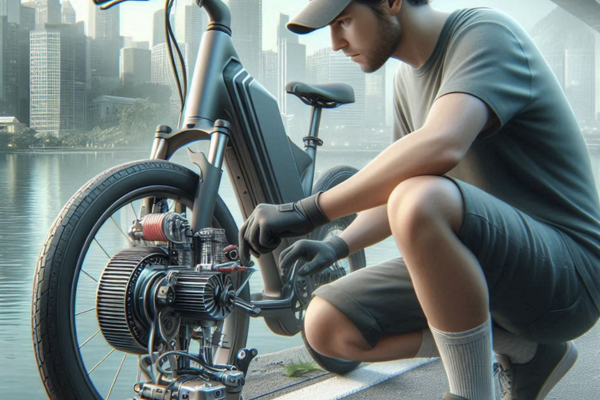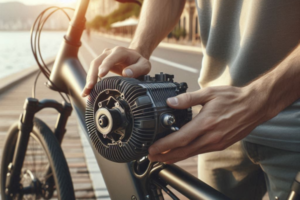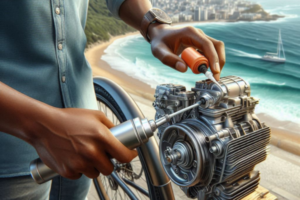🌧️ Understanding the Impact of Humidity on Your E-Bike Motor
Humidity is one of the most persistent and subtle threats to electric bicycles, especially when it comes to the motor. Unlike rain, which is visible and easy to react to, moisture in the air creeps into electronic components silently. In regions with consistently high humidity levels, such as coastal areas or tropical climates, e-bike motors are at constant risk of internal damage.
When water vapor condenses inside the motor or on its connectors, it can lead to rust, corrosion, and short circuits. These issues not only compromise the efficiency of the bike but can cause total motor failure over time. Understanding how humidity affects each part of your motor is key to building a long-lasting maintenance strategy.
Addressing these risks proactively ensures both safety and cost savings. The good news is that you don’t need to be a mechanic — just consistent and aware of the signs of trouble and how to prevent them.
🛠️ Daily and Weekly Preventive Care
Keeping your electric bike motor protected begins with basic habits. These small actions help you avoid bigger problems down the road and don’t require technical skills or expensive products.
Start by making a habit of inspecting your e-bike after each ride. Even on days when the weather seems dry, airborne moisture can settle on the motor and surrounding components. Pay attention to areas like joints, seams, and electrical connections — these are where moisture tends to hide and accumulate.
Avoid using pressurized water when cleaning your bike. Instead, opt for a damp microfiber cloth and gently clean the motor casing. Dry it afterward to prevent condensation from settling in.
🧼 Clean After Each Ride
Use a clean, dry cloth to wipe down the motor housing, paying special attention to corners and cable entry points. Cleaning consistently helps prevent mineral buildup and moisture saturation, especially after riding near bodies of water or through wet areas.
You don’t need special cleaning products — just consistency and care. This simple habit can extend the motor’s life significantly in a humid environment.
🔍 Look for Early Warning Signs
Visual inspections go a long way. Watch for rust-colored stains, flaking paint, or dampness around bolts and vents. These signs can indicate early corrosion. Addressing them immediately can stop damage from progressing deeper into the motor system.
Also check for frayed wires, odd sounds, or unexpected changes in motor response. These can be subtle warnings of hidden moisture inside the housing.
💡 Tip: Consistent daily care is your first line of defense against humidity-induced damage. A few minutes after each ride can save you from costly repairs down the line.
🛡️ Strategies to Protect Your E-Bike Motor from Moisture and Salt
Once you’ve developed a consistent cleaning routine, the next step in corrosion prevention is to build up layers of defense. Humidity and salt are relentless in coastal or tropical environments, and over time they can compromise even the best-engineered motors. Fortunately, there are proven strategies that, when applied together, form a highly effective shield for your electric bike motor.
One of the most important actions you can take is the application of protective coatings. These products create a physical barrier between the environment and your bike’s components. Some are water-repellent sprays, while others are specialized greases or insulating materials that seal vulnerable connections.
🔍 Choosing the Right Type of Protection
Not all protection is equal. Understanding the different types of coatings and where to apply them is crucial to ensuring their effectiveness. Here’s a quick overview:
- PTFE-based sprays: Ideal for motor casings and exposed metal surfaces. They repel water and resist salt buildup.
- Dielectric grease: Used on electrical connectors to prevent moisture-induced short circuits.
- Silicone conformal coatings: Excellent for internal electronics, though these should only be applied by professionals or with proper guidance.
Apply protective products in a dry, well-ventilated area, and always allow them to cure fully. Some require 24 hours to set before they’re effective against corrosion.
🧠 Mini Case: A Costly Mistake in a Coastal City
Andrea, a commuter in a humid coastal town, kept her e-bike under a plastic tarp and assumed the cover was enough. After several weeks, she began noticing clicking sounds and sluggish motor response. Upon inspection, her mechanic found corrosion inside the controller and around key connectors — all because the plastic cover had trapped humidity inside. The fix cost more than $300.
Her story is not uncommon. Without airflow, even “covered” storage can become a hazard. That’s why a breathable bike cover and proper ventilation matter just as much as coatings.
📊 Visual Comparison: Effective Protection Layers
| Protection Element | Purpose | Application Frequency |
|---|---|---|
| PTFE Spray | Repel water on exterior surfaces | Every 2 weeks |
| Dielectric Grease | Seal and protect connectors | Every 1–2 months |
| Silicone Coating | Protect internal circuits | Every 3–6 months or as needed |
🔄 A Simple Comparison to Remember
Think of protecting your motor like protecting your skin. Just as you wouldn’t go into the sun without sunscreen, you shouldn’t ride into salty air or fog without a layer of protection. And just like sunscreen, one application won’t last forever—it needs to be refreshed regularly to stay effective.
💡 Insight: Your motor can’t ask for help—but with the right layers, it never has to.
🏠 Smart Storage: The Silent Guardian Against Humidity
Even with regular cleaning and protective coatings, your motor’s worst enemy might be where you park it. Storage is one of the most overlooked, yet most influential, factors in corrosion prevention. Riders who store their bikes in humid, poorly ventilated environments often experience motor issues even when everything else is done right. Let’s talk about how to transform your storage space into a true ally in motor protection.
Humidity doesn’t just live in the air—it settles on surfaces and seeps into materials. When your e-bike sits for hours in an enclosed space without airflow, especially on concrete floors or near damp walls, moisture slowly collects on the motor casing, bolts, and connectors. This invisible layer becomes a breeding ground for corrosion, especially when paired with leftover salt or dirt from previous rides.
🌬️ Air Circulation is Key
Whether you store your bike indoors or outside, air movement is essential. A small fan or a naturally ventilated spot (like near a window) can prevent stagnant humidity from clinging to the metal parts. If you’re storing your bike in a garage or small room, avoid placing it in corners, as those areas trap moisture most easily.
🛏️ Raise Your Bike Off the Ground
Concrete floors are naturally porous and tend to absorb and release moisture depending on the weather. If your e-bike sits directly on the floor, it is exposed to that moisture every day. Use a bike stand, rubber mat, or even a wooden pallet to raise the tires and motor at least a few centimeters above ground level. This simple adjustment dramatically reduces corrosion risk.
🔲 Use a Breathable Bike Cover (Not Plastic)
Plastic tarps or thick, non-breathable covers might seem like a good idea, but they often trap condensation. Instead, opt for bike covers made from breathable, waterproof fabrics that allow moisture to escape. If storing outdoors, secure the bottom of the cover to prevent wind-driven rain or salt particles from reaching the motor area.
🧘♀️ Mini Visual: Calm vs. Corrosive Storage
Imagine two riders living in the same coastal neighborhood. Lina stores her bike inside, near a window, on a raised stand, and covers it with a lightweight, breathable cover. Miguel stores his bike on the patio under a tarp, directly on the tiled floor. After six months, Lina’s motor still looks clean and responsive. Miguel’s connectors show signs of corrosion, and his motor begins making noise. Same weather. Different outcomes. It’s all about the storage.
💡 Smart Tip: If your bike storage area feels damp to the touch or smells musty, it’s already too humid. Add a low-energy dehumidifier or increase airflow immediately.
Storage may not seem like part of your maintenance plan, but it’s where protection actually begins. You can apply all the coatings and clean your motor perfectly—but if your e-bike sits in poor conditions, corrosion will find its way in. Treat your bike’s resting place as carefully as you treat the ride itself.
💡 Reflection: Think of your motor as a guest. Would you leave it to sleep in the damp corner of a basement? Or offer it fresh air and a clean bed?
⚠️ Common Mistakes Riders Make in Humid Environments
Even riders with the best intentions can fall into habits that silently shorten their motor’s lifespan. In humid climates, where the environment is already against you, small missteps in care or storage can create the perfect conditions for corrosion. Understanding these common mistakes—and how to fix them—is the next step in becoming a truly smart e-bike owner.
❌ Mistake #1: Using the Wrong Cleaning Products
Many riders assume that any cleaning spray will do the job. But some general-purpose cleaners contain harsh chemicals or leave behind oily residues that attract dust and salt. Others may be too acidic or alkaline, slowly weakening protective layers and seals. Always use bike-specific or electronics-safe products that are pH-balanced and residue-free.
❌ Mistake #2: Skipping Drying Steps After Cleaning
Cleaning the motor without drying it completely is like taking a shower and never drying your hair. Moisture trapped in corners or under seals will linger long after the bike is stored. If not removed, it begins interacting with oxygen and metal—an ideal setup for corrosion. After every cleaning, always dry the motor area carefully with a soft cloth and let it air out.
❌ Mistake #3: Forgetting to Reapply Protection
Protective sprays and greases don’t last forever. Exposure to rain, heat, and daily movement gradually wears them away. Riders who apply once and forget may think they’re protected, but in reality, their coating has long since degraded. Reapply on a regular schedule, and especially after riding in fog, rain, or through salty air.
❌ Mistake #4: Storing the Bike in “Hidden Humidity” Zones
You might think your bike is safe in a closed closet, behind a curtain, or under a thick tarp. But these locations often trap moisture. They lack air movement and are often in contact with concrete walls or floors that release humidity throughout the day. Always evaluate storage zones not just by appearance—but by ventilation and dryness.
📊 Table: Mistakes and Their Impact
| Mistake | Short-Term Effect | Long-Term Risk |
|---|---|---|
| Wrong cleaner | Leaves residue | Accelerates corrosion |
| No drying | Traps moisture | Creates rust under surface |
| No reapplication | Coating wears off | Unprotected motor exposed |
| Poor storage spot | Hidden condensation | Slow damage to electronics |
📋 Checklist: How Many of These Apply to You?
- ☐ I use bike-specific cleaning products
- ☐ I always dry my motor area after washing
- ☐ I reapply protection regularly
- ☐ I’ve evaluated my bike storage for humidity
- ☐ I’ve learned from at least one mistake above 😅
We all make mistakes—what matters most is correcting them and moving forward with better care. A little awareness today prevents big problems tomorrow. Use this section as a reminder, a reset, or a checklist to share with fellow riders who may not yet know how humidity silently sabotages their motor.
💡 Reminder: Prevention isn’t about being perfect—it’s about being present. And now, you’re more prepared than most.
💬 Frequently Asked Questions (FAQs) About Motor Care in Humid Environments
Can I ride my e-bike in humid weather without damaging the motor?
Yes, but only if you commit to regular care. Riding in humidity won’t automatically cause damage, but the combination of moisture and neglect is what leads to corrosion. Clean your bike regularly, dry it thoroughly, and reapply protective products on schedule.
Is it safe to use anti-rust sprays on all parts of the motor?
Not always. Use only electronics-safe and non-conductive sprays for any area near connectors or circuits. For external metal surfaces, PTFE-based anti-corrosion sprays work well. Always read the product label and apply sparingly in targeted areas.
How do I know if my motor already has corrosion?
Look for visual signs like discoloration, powdery white or orange spots near bolts, or changes in motor performance such as rough acceleration or unusual noises. If you suspect internal damage, it’s best to have a technician inspect the motor before it worsens.
What’s the best way to store my e-bike overnight in a coastal city?
Choose a dry, ventilated space—preferably indoors. Use a breathable bike cover if needed and raise the bike off concrete floors. Avoid plastic tarps, dark corners, or areas near humid windows. If your storage smells musty or feels damp to the touch, it’s time to improve airflow or use a small dehumidifier.
💖 Final Thoughts: Protect What Moves You
Your e-bike is more than a machine—it’s your partner in mobility, your ticket to freedom, and your daily connection to the world outside. And like anything valuable, it deserves thoughtful protection. The reality is that corrosion doesn’t happen all at once. It starts quietly. Invisibly. But so does prevention.
With each wipe-down, each inspection, each intentional moment of care, you are telling your bike: “I’m in this with you.” That consistency transforms your e-bike from a vulnerable tool into a well-guarded companion—capable of enduring the salt, the humidity, and the long road ahead.
You don’t need fancy equipment or deep mechanical knowledge to protect your motor. You just need to care. And now you do—better than most.
💡 Inspiration: Great riders aren’t defined by how far they go—but by how well they protect what gets them there.
🌎 Join the Conversation: What’s Your Corrosion-Proof Routine?
Are you living in a humid environment? Have you learned a clever way to keep your motor dry and happy? Or did you make a mistake that taught you a valuable lesson about salt and storage? Your experience can help others ride smarter.
Share your thoughts, tips, or questions below. Let’s build a supportive space where riders across the world can learn from each other, protect their rides, and feel proud of how far they’ve come—rain or shine.
Because corrosion is silent… but so is smart care. And you’ve already started riding the wiser path. 💙🚴♀️



